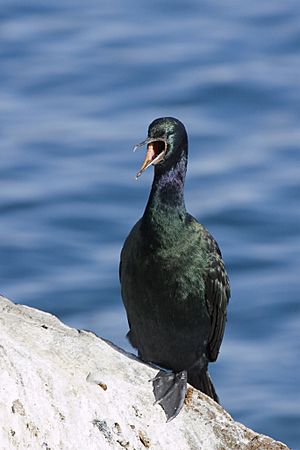Pelagic cormorant facts for kids
Quick facts for kids Pelagic cormorant |
|
|---|---|
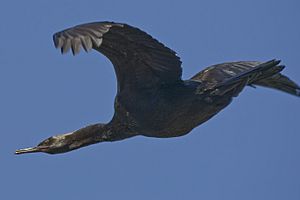 |
|
| Nonbreeding adult (probably P. p. resplendens) flying off Morro Rock (California, United States) | |
| Conservation status | |
| Scientific classification | |
| Subspecies | |
|
2 subspecies (but see text) |
|
| Synonyms | |
|
Leucocarbo pelagicus (Pallas, 1811) Phalacrocorax kenyoni (Siegel-Causey, 1991) |
The pelagic cormorant (Phalacrocorax pelagicus), also known as Baird's cormorant, is a small seabird. It belongs to the cormorant family. Sometimes, it is also called the pelagic shag. This bird lives along the coasts of the northern Pacific. In winter, it can also be found in the open ocean. Pelagic cormorants have short wings. This helps them move easily underwater. However, it makes flying more difficult for them than for other birds.
Contents
What They Look Like
This cormorant is fairly small. It is about 25 to 35 inches (64 to 89 cm) long. Its wingspan is about 3.3 feet (1 meter). A grown bird weighs between 52 and 86 ounces (1,474–2,438 grams).
When they are not breeding, adults are all black. They have a shiny, metallic look. During breeding season, they grow two small crests. One is on top of their head and one is on their neck. They also get white patches on their thighs. Small white feathers appear on their head and neck. Their long, thin bill and large webbed feet are black all year. The bare skin patch below their eye turns a bright pink-purple color during breeding season.
Males and females look similar. However, females are a little smaller. Young birds are dark brown and do not have the metallic shine. Their underside is a bit lighter brown.
The red-faced cormorant (P. urile) looks very much like the pelagic cormorant. These two species often live in the same areas. When breeding, adults are easy to tell apart. The red-faced cormorant has more bare skin on its face. This skin goes above its bill and around its eye. The pelagic cormorant's bare skin does not go much beyond its eye. The red-faced cormorant also has bigger crests. Young birds and nonbreeding adults of both species can be hard to tell apart. This is especially true if they are in mixed groups or far away. The red-faced cormorant is also larger. Unlike the red-faced cormorant, the pelagic cormorant usually makes a sound before it flies off. This is especially true during the breeding season.
Where They Live
The pelagic cormorant lives along the coasts of the North Pacific. Its range in North America goes from Alaska down to the Baja California Peninsula in Mexico. It is also found on the Aleutian Islands and other islands in the Bering Strait. In Asia, it lives from the Russian Far East Chukchi Peninsula south to Kamchatka and Kyūshū (Japan).
Birds from colder, subarctic areas migrate to warmer places for winter. Birds from temperate and subtropical areas do not travel far after breeding. They just spread out locally. Sometimes, Asian birds can reach China or Korea. A few birds have even been seen in the Hawaiian Islands.
Life and Habits
What They Eat
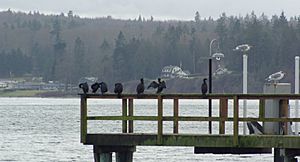
On land, pelagic cormorants are a bit clumsy. They walk with a high-stepping, wobbly walk. This is common for cormorants. After landing, they often scratch the ground. If they feel threatened, they will quickly point their bills at the danger. They also shake their heads and make a gurgling sound.
This bird finds food by swimming. Then, it dives underwater to catch its prey. It uses its feet to push itself through the water. Its wings help with steering. It can dive as deep as 140 feet (43 meters) to find food on or near the seafloor. They usually hunt in calm inlets and bays. Outside the breeding season, they can also be seen fishing far out at sea. They like to hunt near kelp beds or among rocks.
They mostly eat small fish that live on the bottom. These include sand eels, sculpins, gunnels, and rockfish. Besides fish, they also eat small crustaceans, especially shrimp. They have been seen joining other birds to hunt groups of young Pacific herrings.
Like all cormorants, their feathers are not fully waterproof. This is because they have a very small oil gland. So, after fishing, they go to a safe place to preen and dry their feathers. They often stand with their wings spread out to dry them.
Reproduction
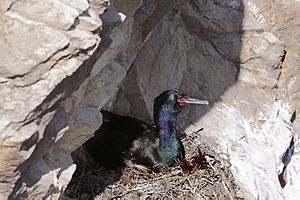
The pelagic cormorant builds its nests on rocky shores and islands. They do not form very large colonies. Instead, smaller groups may nest together. Sometimes, these birds use different nesting spots in an area each year. The nest is built on a cliff face, usually on ledges. Less often, they build in cracks or caves. The nest is made from stringy plants, like grasses or seaweed. The birds use their own guano (poop) to hold it all together.
Once they find a good nest site, they often use it for the rest of their lives. They fix and improve the nest each season if needed. A nest can grow to be up to 5 feet (1.5 meters) deep!
Males looking for a mate or bonding with their partner do a special courtship display. This is common for these types of birds. They stretch their throat pouch and make repeated "yawning" movements. They also arch their neck and hop. They lift their folded wings and quickly flutter them to show their white thigh patches. During the "yawning" display, they throw their head back and make calls. The calls are different for males and females. When the birds land, males and females make the same call. Other displays are usually silent.
A female usually lays between two and five eggs. Most often, it is three or four. But sometimes, up to seven eggs have been found. The eggs hatch after 3 weeks of incubation. When they hatch, the young birds weigh a little more than an ounce (35 grams). They are born without feathers, but soon grow soft, sooty-gray down feathers. In good years, all the young birds in a nest may grow up successfully. But usually, fewer than four chicks leave the nest. They can start having their own babies when they are two years old. The oldest pelagic cormorant found in the wild lived to be almost eighteen years old.
Conservation Status
This species is very common and found in many places. So, the IUCN does not consider it to be in danger. Most of its population lives in the hard-to-reach waters of the Bering Sea. About 50,000 pairs breed in the Kuril Islands, the Bering Sea islands, and Alaska. About 25,000 pairs breed along the Pacific coast of North America. About 60% of these are in California.
Sometimes, oil spills can temporarily wipe out local groups of these birds. Also, competition with gillnet fisheries and getting caught in these nets can limit their numbers.
About Their Name
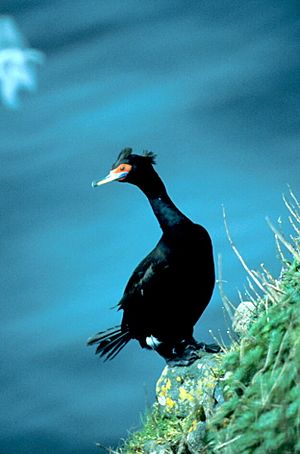
The scientific name for the pelagic cormorant is Phalacrocorax pelagicus. This name comes from ancient Greek and Latin. Phalacrocorax is an old word for cormorants. It means "bald raven". Pelagicus means "of the open seas". This is where the English word "pelagic" comes from.
If the Phalacrocorax group were split up, the pelagic cormorant would likely be called Compsohalieus. This name means "sleek fisher".
Subspecies
There are two main types, or subspecies, of the pelagic cormorant. They are only slightly different. The main difference is their size, which follows a rule called Bergmann's Rule. This rule says that animals in colder places tend to be larger.
- Phalacrocorax pelagicus pelagicus (Pallas, 1811) – This is the Northern pelagic cormorant. It lives in the northwest Pacific east to southern Alaska. This subspecies is generally larger.
- Phalacrocorax pelagicus resplendens (Audubon, 1838) – This is the Southern pelagic cormorant. It lives from British Columbia to northwest Mexico. This subspecies is generally smaller.
There was once thought to be another species called the Amchitka cormorant or Kenyon's shag (P. kenyoni). It was found from bones in the Aleutian Islands. People thought it might have gone extinct in the 1960s–1970s. However, later studies showed that these bones likely belonged to small female pelagic cormorants. The differences were not enough to make it a separate species.
Scientists found that pelagic cormorants from the Aleutians are usually small. But birds from western Alaska are often very large. More research is needed to understand these size differences. It is possible that the Aleutian population could be a distinct subspecies. If so, the name kenyoni would be used for it.
Images for kids
-
Nonbreeding adult (probably P. p. resplendens) flying off Morro Rock (California, United States)
-
Nonbreeding adult P. p. resplendens on Morro Rock (California, United States)
-
Pelagic cormorants (presumably P. p. resplendens) at Kitsap Peninsula (Washington, United States) preening after fishing. Note spread-winged posture of bird in center.
-
Adult on a nest in San Luis Obispo, California, United States
-
The largely sympatric red-faced cormorant (P. urile, shown here in breeding plumage) is the pelagic cormorant's sister species
See also
 In Spanish: Cormorán pelágico para niños
In Spanish: Cormorán pelágico para niños



